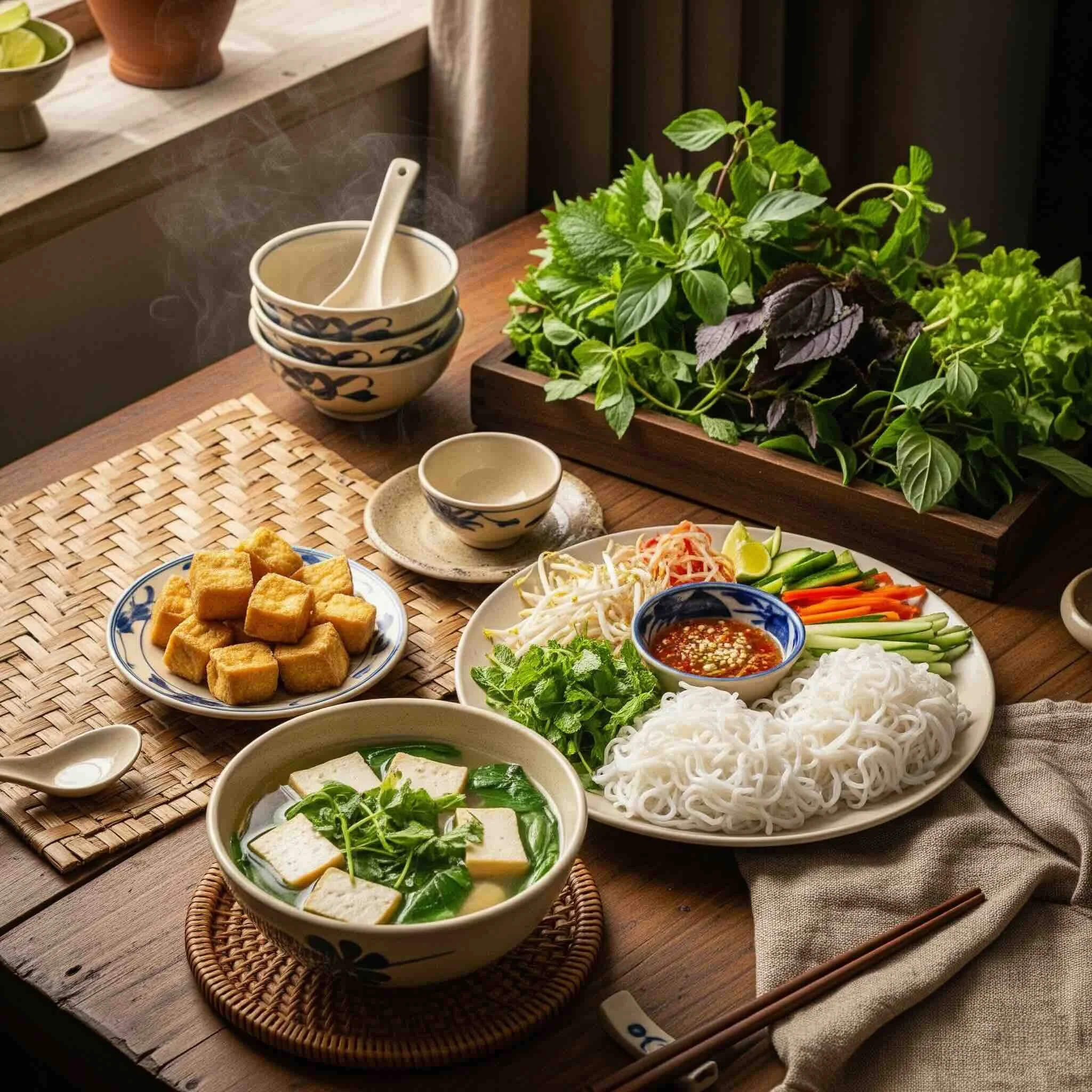Vietnamese Cooking: How Plants Became the Main Event
🌿 Fresh by Design: The Plant-Centric Heart of Vietnam’s Cuisine
Vietnamese cooking isn’t just accidentally plant-based. It’s designed around freshness and balance, where herbs, tofu, noodles, and dipping sauces take centre stage.
Even in traditional dishes with meat, the plate is often not meat-dominant. Instead, you’ll find a vibrant spread of rice, greens, pickles, and dipping sauces, where soy-based proteins like tofu and yuba easily step in.
This isn’t substitution. It’s tradition.
From Buddhist roots to family kitchens, Vietnam has long shown how plants can be the main event, not just the side dish.
🍜 The Power of the Bowl: Bún, Phở Chay & More
Vietnamese home cooking shines in its bowls—layered, bright, and deeply satisfying. Many of the most iconic dishes are either already plant-based or effortlessly adapted.
Bún (Vermicelli Noodle Bowls)
Light rice noodles topped with fresh herbs, crisp vegetables, marinated tofu or yuba, and crushed peanuts.
Add nước chấm (dipping sauce) and it becomes a perfect balance of salty, sweet, tangy, and spicy.
Phở Chay (Vegetarian Phở)
A meatless version of Vietnam’s most famous noodle soup.
The broth is usually made with charred onions, daikon, carrots, cinnamon, star anise, and cloves—rich, aromatic, and soothing.
Toppings include tofu, yuba, mushrooms, and loads of fresh herbs.
Gỏi Cuốn (Rice Paper Rolls)
Stuffed with tofu, mint, noodles, and lettuce. Served with peanut hoisin sauce or soy-based nước chấm.
🧈 Pro Tip: Use yuba (tofu skin) for an extra layer of chew and depth in noodle bowls, soups, and spring rolls.
🧂 Nước Chấm: The Soul of the Table
Vietnamese meals often revolve around dipping sauces—complex yet easy to prepare.
Nước chấm is the most iconic, traditionally made with fish sauce, but easily plant-based with:
Soy sauce or tamari
Lime juice or vinegar
Sugar
Garlic & chilli
It’s poured over bowls, used as a dip, or mixed into salad-style dishes. In a plant-based kitchen, nước chấm isn’t just a sauce—it’s a flavour builder.
🌱 Tofu & Yuba: Not Just Protein, but Texture & Tradition
Tofu has long been a fixture in Vietnamese Buddhist kitchens, not as a substitute, but as a central ingredient.
Tofu: Fried until golden or braised in lemongrass and tomato sauce.
Yuba: Rehydrated and stir-fried for chew, or served cold with herbs and sesame oil.
Firm tofu: Often sliced into bún bowls or added to phở.
Soft tofu: Gently simmered in broth or used in desserts (tàu hũ nước đường).
These soy-based staples are prized for their ability to soak up flavour, hold structure, and contrast the crispness of herbs and vegetables.
🍃 Herbs First: How Balance Defines the Cuisine
If there’s one rule in Vietnamese cooking, it’s balance.
A meal isn’t complete without a handful of herbs—mint, Vietnamese balm, Thai basil, perilla, or coriander—each chosen for its cooling, aromatic, or digestive properties.
Herbs aren’t just garnish. They’re medicine, texture, and philosophy. They bring freshness to fried tofu, depth to soup, and complexity to every bite.
And they reflect a deeper cultural value: that food should nourish more than hunger—it should balance the body and spirit.
🥗 Serving Ideas to Try at Home
You don’t need to master Vietnamese cuisine to start enjoying its wisdom. Here are a few ways to bring it to your kitchen:
Build a Bún Bowl: Cook vermicelli noodles, top with marinated tofu or yuba, carrots, cucumber, mint, and nước chấm.
Try Phở Chay: Make a light vegetable broth with charred onion, star anise, and ginger. Serve with rice noodles, tofu, and basil.
Wrap a Gỏi Cuốn: Use rice paper sheets to roll tofu, noodles, and herbs. Dip into peanut sauce or vegan nước chấm.
Blend a Sweet Treat: For dessert, blend silken tofu with coconut milk and a touch of maple syrup. Chill and top with fruit.
✨ Final Takeaway: A Cuisine Where Plants Were Always Enough
Vietnamese food doesn’t need to “go plant-based.” It’s already there.
In every home-cooked bowl of bún or broth of phở chay lies a quiet truth: flavour doesn’t depend on meat—it depends on care, balance, and fresh ingredients.
From tofu to herbs, from street carts to family kitchens, Vietnamese cuisine proves that plants have always been powerful enough.
Let’s celebrate it—not as a compromise, but as a legacy.

